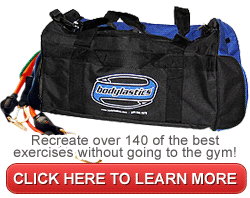Strength Profiles
Nov 10, 2009

Get an idea of what you can do to enhance your stength!
Exercise equipment might fall under three broad categories:
• Constant resistance
• Accommodating resistance
• Variable resistance
Most professionals consider free weight training as constant resistance, however, if you know anything about biomechanics, there is nothing constant about it, unless of course we don’t move the weight. As we push or pull, the muscles are changing length, the relationship of the resistance to the axis of motion is changing and of course acceleration, inertia, momentum and all of those other words of physics we love (or hate) come into play.
Accommodating resistance is designed to exert force through a speed-controlled range of motion. Iso-kinetic resistance equipment is accommodating. Some professionals might argue that aquatics, hydraulics and pneumatics are undefined because they fall into both accommodating and variable resistance categories.
I personally consider aquatics accommodating because the person defines the resistance based on the amount of water and speed of movement. Variable resistance is designed to change the external load throughout an exercise’s range of motion. Most of the equipment we use in the gym falls under this category. Human strength profiles are based on movements around a single joint or multiple joints. The profiles are then classified under three categories: ascending, descending and bell-shaped which are determined by the torque or force-angle relationship between the joint or joints moving.
(1) A Personal Trainer or Health Care Practitioner’s understanding of the benefits and limitations of the different modes of resistance and how they might match up to the natural strength profiles would be highly beneficial to the long term success and injury prevention of their clients or patients.
Strength Profiles
Strength profiles of a single joint are generally easier to figure out than multi-joint movements. The majority of athletic movements such as running, kicking, punching or throwing occur in sequential order with the larger proximal joints and muscles followed by the smaller distal joints and muscles.This is known as the “summation of speed principle.” (2) When the segments of multi-joint movements used in a bench press, leg press, squat and power clean approach full extension, the musculo-skeletal lever system gains mechanical advantage. These exercises have ascending strength. In a descending strength profile, maximum strength is produced at the start of the lift. Examples are pull-ups, chin-ups, lat pull-downs and bent-over rows.
Single Joint exercises
Single joint exercises have more of a bell-shaped curve where maximum strength occurs around the middle of the lift. (3). Examples are arm or leg curls, leg extension or triceps extension.Lever systems
Cams and lever systems on variable resistance equipment are designed to change the external moment arm (which affects the distance of the resistance to the axis) to match up to the changing moment arm or mechanical leverage of the user during the exercise.In this way, the equipment manufacturer attempts to approximate maximal, external resistance to match the musculoskeletal systems ability (mechanical advantage) to produce force at the same instance. In these cases, the equipment is actually getting harder as the user gets stronger. For people that believe that “equipment should match the user,” not “the user should match the equipment” or that exercises should be “functional,” then it’s imperative as Personal Trainers and Health Care Practitioners to consider our natural strength profiles and match them accordingly with the resistance profiles of the exercises prescribed.
So what can you do?
So how does this apply to you and what can you do to take advantage of the equipment used in a gym to increase along the muscles strength curve? Simple- Grab a pair of strength bands and use them appropriately in combination with FREE weight.Why?
Here are a few reason as to why.
Linear variable Resistance Principles- As the weight gets progressively heavier with the bands during a muscles range of motion your body will be forced to push or pull harder and with more force thus recruiting more muscle fibers during the movement of the exercise. The further the bands strength the heavier the force becomes.
True power Training- The other advantage is that you can now institute a different speed at which you can now move the weight because of the Elastic resistance. Ion other words now that the free weight has little to no momentum you can ‘speed up” the exercise to where the muscle fibers are now contracting faster producing your body to recruit the fast firing type 2B muscle fibers in the muscle being emphasized in the exercise performed.






